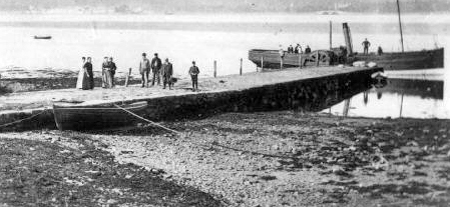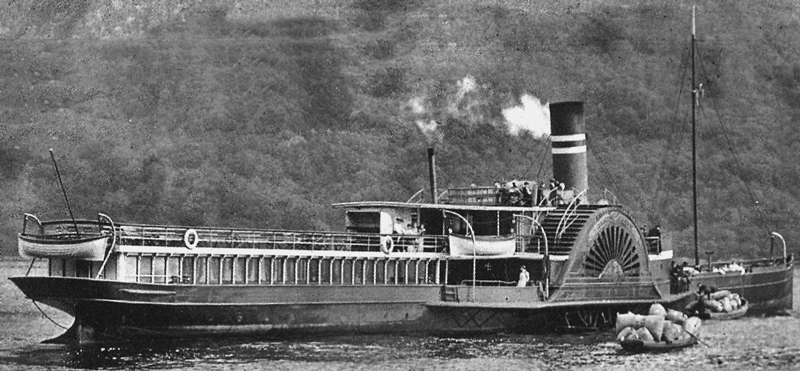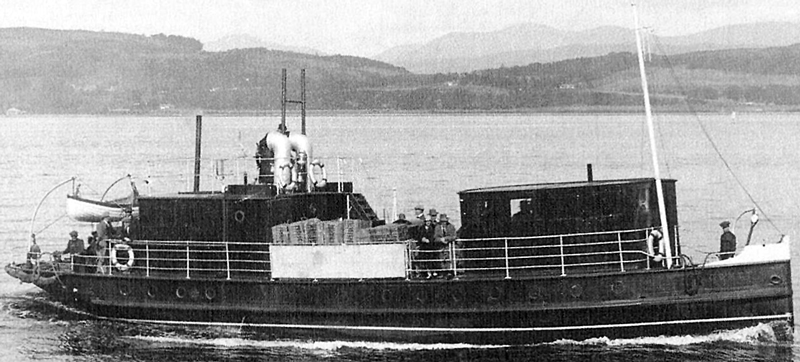WRITING in the Glasgow Herald on December 14 1849 "Citizen" referred to Lochgoilhead as being part of "the principal route to Inveraray". This may seem very strange to modern eyes, but it must be remembered that in those days the sea was the highway.
Furthermore although Helensburgh perhaps only occasionally formed part of this highway, Kilcreggan and Cove most definitely were part of it. So, where exactly did this route go, which means of transport were involved, and what brought about its demise?
The Route

The business most associated with this route was the Lochgoil and Lochlong Steamboat Company. An advertisement which they placed in the Glasgow Herald on 16 August 1878 shows one of its vessels sailing from the Broomielaw in Glasgow and calling at Dumbarton, Greenock, Gourock, Kilcreggan, Cove, Blairmore, Ardentinny, Carrick Castle and Douglas Pier before reaching Lochgoilhead.
A little later the same day another of its boats followed nearly the same route, but called at Dunoon and Kirn instead of Kilcreggan and Cove. Importantly, this company had a contract to carry the Royal Mail.
On Thursdays in 1880 the West Highland Carrying Company followed an even longer route. After calling at Helensburgh, Kilcreggan and Cove, its vessel would visit all the Holy Loch piers as well as Coulport. After leaving Lochgoilhead, its itinerary took it to Portincaple, Murligan Ferry (now Morelaggan) and Arrochar.
Ardentinny and Portincaple on opposite banks of Loch Long never had piers, and steamers were met by ferries coming out from the shore, usually in the shape of open rowing boats. Sometimes passing steamers could be hailed by the ferries to pick up passengers, even although perhaps not timetabled to do so.
Although the construction of Coulport Pier started in 1880, technical problems meant that it did not come into use until 1882. Prior to that a ferry would come out to the steamers there too.
In 1870 a Mr Paul of Glasgow who owned a summer residence at Coulport took the Lochgoil and Lochlong Steamboat Company to court.
He had purchased a book of 24 tickets on special terms for travel from "Glasgow to or from Ardentinny or Coulport." However after the 1st July in that year the steamer stopped calling for the ferry at Coulport, and so Mr Paul had to take a carriage to Cove, the nearest pier, thus incurring extra expense. It would appear that his claim was settled out of court.
After reaching Lochgoilhead passengers for Inveraray would now board a horse-drawn coach to take them through Hell's Glen to St Catherines on the east shore of Loch Fyne – a journey of nearly 9 miles (14 kms) and involving quite a steep climb.
A visit could then be made to the Ferry Inn at St Catherines before crossing the Loch to Inveraray. A ferry was first recorded there in 1680 and it continued until 1963. Sadly today, although the Old Ferry Inn still stands, it is derelict and has been so for many years.

In Victorian times for the last leg of their journey to Inveraray passengers would board a small 60 foot (18 m) long paddle steamer called the "Fairy" which had been built in 1865 to travel across Loch Fyne, and which was replaced in 1893 by another vessel of the same name (pictured).
As Argyll’s county town at that time, Inveraray was an important destination in its own right.
The Shipping Companies
The Lochgoil and Lochlong Steamboat Company was formed in 1825, only 13 years after Henry Bell's "Comet". They had a succession of paddle steamers on the route, with at least two being called "Lochgoil" and two "Lochlong". Later came the "Carrick Castle " and the "Windsor Castle".
The last and perhaps best-known of their fleet was the "Edinburgh Castle" which was built in Port Glasgow in 1879 – and which was notable for its extremely large paddle boxes!
A photograph taken in the 1900s shows her slightly off her usual route, lying off Coilessan on the western shore of Loch Long, where bales of wool are being ferried out to her on board open rowing boats. This of course reminds us that these vessels were not purely for passengers alone.
The Lochgoil and Lochlong Steamboat Company by no means had a monopoly of the route, particularly in summer. In addition to the West Highland Carrying Company an assortment of excursion steamers came out not just from Glasgow, but also from resorts in the Clyde, where the route to Lochgoilhead and Inveraray could become part of a circular excursion.
In 1868 the Lochgoil and Lochlong Steamboat Company took one of its competitors, Capt Macintyre of the steamer "Ardencaple", to court at Inveraray. As a result he was obliged to remove his vessel from the inside berth at Lochgoilhead Pier 10 minutes after passengers and cargo had embarked in order to make way for any other steamer calling there.
Competition also came from the steamers of the four railway-owned companies as well as from David MacBrayne. Furthermore, in 1880 the railway line to Oban opened, which gave passengers the opportunity of travelling to Inveraray by train as far as Dalmally, and then by horse-drawn carriage for the 16 mile (26 kms) trip over the hill to Inveraray. Ten years later construction of the West Highland Railway started.
In 1877 a closely-related business, the Glasgow and Inveraray Steamboat Company, was set up. It had the same manager as the Lochgoil and Lochlong Steamboat Company, many of the same shareholders, and even the same colour scheme for its vessels. Its purpose was to provide a direct tourist connection to Inveraray by ship travelling via Rothesay and the Kyles of Bute. The Glasgow and Inveraray Steamboat Company owned a paddle steamer called the "Lord of the Isles". It was so successful that it was replaced by a bigger vessel of the same name 14 years later.
The only other vessel owned by the Glasgow and Inveraray Steamboat Company was a small screw steamer called the "Fairy Queen". It operated on Loch Eck, and thus gave passengers the opportunity of doing a circular excursion, with the sections to and from Loch Eck being carried out by horse-drawn carriage.
Two Opportunities
The opening of the West Highland Railway in 1894 presented in the eyes of some people an opportunity for the Lochgoil and Lochlong Steamboat Company – and also for some of its rivals.
The Glasgow Evening Post of the previous year reported that "a station is to be placed at Portincaple, Loch Long, when the West Highland Railway is completed, and a new steamer will run daily between Portincaple and Lochgoilhead, bringing the latter 40 minutes nearer Glasgow."
However in the event it was two years after the opening of the West Highland Railway that Whistlefield station was built to serve Portincaple. A jetty was also built there at this time, but a pier was ever built, although it is believed that work on one did start.
Perhaps the steep climb from the shore at Portincaple up to the station was unlikely to be attractive to a commuter wanting Lochgoilhead to be brought "40 minutes nearer Glasgow", and so there would probably never have been enough business to make a pier profitable.
At one point a suggestion had been made that Portincaple and Whistlefield station might be linked by a funicular railway, but that obviously never happened – what a tourist attraction that might have been! Consequently the fisherfolk of Portincaple had to carry their fish by one means or another up to Whistlefield station – and given that to this day the road does not go down to the shore at Portincaple, the first stage of the journey was performed by a horse, which could be attached to a cart for the second stage once the road was reached.
The second opportunity proved much more fruitful to the Lochgoilhead steamers than the opening of the West Highland Railway. In 1905 a part of the Ardkinglass estate was bought by Cameron Corbett MP, who then donated it to Glasgow City Council. His wish in doing so was to give increased access to the beautiful countryside between Loch Goil and Loch Long to the citizens of Glasgow, who at that time were living in a city which heavy industry had made dirty, smoky and polluted.
The extra traffic on the route materialised and this was enhanced two years later when the Young Men's Christian Association (YMCA) asked Glasgow City Council if they could build a permanent campsite on Ardgoil (as the estate was now known). This included a dining hall capable of seating 400 – and of course the majority staying there would have come by steamer.
In making his gift to Glasgow City Council, Cameron Corbett made two conditions. Firstly, the revenue derived from the sheep farms on the property should be used to make Ardgoil more accessible to the citizens of Glasgow – and, secondly, the sale of alcohol on Ardgoil would be prohibited!
The Beginning of The End
However a new form of competition for all the paddle steamers on the Clyde arrived in 1901 in the shape of the first turbine steamer in commercial service in the world, the "King Edward". This vessel was so successful that others rapidly followed with the result that both the Lochgoil and Lochlong Steamboat Company and the Glasgow and Inveraray Steamboat Company became bankrupt in 1909, although other factors were probably at play as well. Furthermore steamers were beginning to lose traffic to motor vehicles on the roads.

A new business, named the Lochgoil and Inveraray Steamboat Company, was formed to take over the assets of the two old companies. These consisted of the paddle steamers "Edinburgh Castle" (pictured) on the Lochgoilhead route and "Lord of the Isles" on the Inveraray route, as well as the "Fairy Queen" on Loch Eck.
Three years later the new company signed a contract with Finlay McNab of Portincaple to place his motor boat on a new service from Princes Pier in Greenock to Lochgoilhead. His great-granddaughters, Helen Rodger and Louise Porter, still have a copy of the letter to him from the Lochgoil and Inveraray Steam Boat Co. Ltd on its headed notepaper.
Probably the principal reason why Finlay McNab was awarded this contract was that his boat was powered by a motor (believed to have been a Lister diesel) rather than by a steam engine – and this was far from common in those days.
However Finlay McNab's new contract was only to last for about a year. Also in 1912 the Lochgoil and Inveraray Steam Boat Company was taken over by Turbine Steamers Limited, and the following year the old paddler "Edinburgh Castle" went to the shipbreakers.
The Royal Mail contract for the Lochgoilhead route was taken over by David MacBrayne Ltd in 1913. Initially they placed one of their own paddle steamers on the route, but two years later a new, pioneering vessel was placed on the route.
It was one of the very first motor-driven, sea-going passenger vessels in Britain and, when MacBraynes had acquired this small ship in 1907, they changed its name to "Comet" in homage to Henry Bell's 1812 pioneering vessel of the same name.
It takes time to get a steam engine ready. The fire must be lit, but the engine cannot be used until sufficient steam pressure has built up. Then, at the end of its journey the fire must be banked down so that it is at least partially ready for the next day's work – and of course all of this involved extra cost.
MacBrayne's "Comet" was only 65 feet (20m) long and had been built built in London in 1905; it was originally given the name "Win". Because marine diesel engines were in their infancy at that time, and because petrol engines were regarded as riskier, the "Comet" was given a paraffin engine, which was finally replaced by a diesel engine over 20 years later.
Initially MacBrayne's had used their "Comet" on the Crinan Canal or between Ballachulish and Kinlochleven, but in 1915 it was placed on the Lochgoilhead route. It is a measure of how much traffic had fallen away that such a small vessel was considered sufficient – although of course much larger excursion steamers continued to visit Lochgoilhead in the summer.

Meantime, the Lochgoilhead route became shorter. The "Comet" (pictured) started its daily trips all year round from Princes Pier in Greenock; this pier has been replaced by the Ocean Terminal now used by ocean-going vessels, including the cruise liners.
Coulport Pier had already disappeared from the Lochgoilhead itinerary. Although it had only opened in 1882 it was in service for just 15 years. Paddle steamer skippers felt that the approaches to this pier were unsafe. Furthermore, the pier had been built partly for speculative reasons to encourage wealthier travellers to build their villas there; however most preferred Cove and Kilcreggan.
However all was not retrenchment. Somewhat surprisingly the 1937-38 timetable of the London and North Eastern Railway (LNER) had details of a motor launch service from Whistlefield to Lochgoilhead, operated by Hector Blair of Lochgoilhead. How long this lasted is not known.
In October 1946 MacBraynes withdrew the "Comet" from the Lochgoilhead route, and thus the Royal Mail service came to an end. The "Comet" was sold to the south of England the following year and carried out a variety of services there. Remarkably this vessel built in 1905 was at least until recently still in use. Now called the "Gradely" she no longer sails but is a houseboat at Shoreham-by-Sea in West Sussex.
During and after the Second World War piers at Cove, Carrick Castle and Douglas closed down, and ferries no longer came out to meet the steamers at Ardentinny and Portincaple. The Lochgoilhead route was reduced to just a few days a week, and as part of the "Three Lochs Tour" the "Waverley" took passengers from Craigendoran to Lochgoilhead and to Arrochar. If they wished, they could then cross through the glen to Tarbet to join the "Maid of the Loch" for a trip on Loch Lomond, thus giving them a circular tour.
The pier at Lochgoilhead closed in 1965, and today very few would realise that Lochgoilhead was just over a century earlier part of the "principal route to Inveraray".
Sources:
- Four websites by "valeman" - see www.dalmadan.com.
- Portincaple
- Lochgoilhead Pier
- Douglas Pier on Loch Goil
- To Dark Lochgoil
- Joy Monteith and Ian McCrorie: Clyde Piers – a pictorial record (Inverclyde District Libraries, 1982).
- Nick S Robbins and Donald E Meek: The Kingdom of MacBrayne (Birlinn Ltd, 2006).




